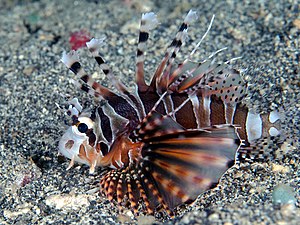Zebra pygmy lionfish
| Zebra pygmy lionfish | ||||||||||||
|---|---|---|---|---|---|---|---|---|---|---|---|---|

Zebra pygmy lionfish ( Dendrochirus zebra ) |
||||||||||||
| Systematics | ||||||||||||
|
||||||||||||
| Scientific name | ||||||||||||
| Dendrochirus zebra | ||||||||||||
| Cuvier , 1829 |
The zebra pygmy lionfish ( Dendrochirus zebra ) is a member of the scorpion fish (Scorpaenidae). It lives in deep lagoons , corals and rock reefs of the Red Sea as well as the tropical Indo-Pacific from South and East Africa to Australia , South Japan , Samoa , Tonga and Lord Howe Island at depths of three to 60 meters. He is said to have been to the Philippines particularly often . However, many stocks have declined sharply as a result of being caught for aquarium purposes.
features
The zebra pygmy lionfish is drawn in red and white. A row of dark red, broad, vertical bands runs across the body. The pectoral fins are large and look like butterfly wings. At the base of the tail, two bands are connected by a transverse band, so that an H-shaped pattern results. The first hard-rayed dorsal fin has 13 fin rays , which are provided with poison glands, the middle fin rays are higher than the body height. The second dorsal fin has ten to eleven soft rays. The anal fin has three hard and six to seven soft rays. Here, too, the hard rays and the only one of the pelvic fins are connected to poison glands. There is a dark spot on the bottom of the gill cover. Zebra pygmy lionfish grow to be about 18 centimeters long. Males grow larger than females and have a slightly larger head.
Way of life
The fish live individually, the females also in small groups. During the day they stay in caves or under overhangs. Some populations are associated with the vase sponge Xestospongia testudinaria . Zebra pygmy lionfish feed mainly on small crustaceans , stomach examinations revealed 80% shrimp, 10% crab and 10% woodlice, and only a few small fish such as damselfish and cardinalfish . They spawn before sunrise or after sunset. The pelagic larval stages are widely displaced by currents.
literature
- Hans A. Baensch / Robert A. Patzner: Mergus Sea Water Atlas Volume 6, Non-Perciformes (non-perch-like). Mergus-Verlag, Melle, ISBN 3-88244-116-X .
- Ewald Lieske / Robert F. Myers: Coral fish of the world . Year publisher, 1994, ISBN 3-86132-112-2 .
- Dieter Eichler / Robert F. Myers: Coral fish Central Indo-Pacific . Jahr Verlag, Hamburg 1997, ISBN 3-86132-225-0 .
Web links
- Zebra pygmy lionfish on Fishbase.org (English)
